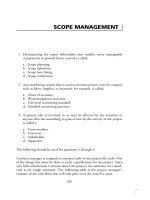Business lecture CHAPTER 11a
Bạn đang xem bản rút gọn của tài liệu. Xem và tải ngay bản đầy đủ của tài liệu tại đây (146.99 KB, 36 trang )
Chapter 11
The Strategy of
International Business
11-1
Introduction
Question: What actions can managers take to compete
more effectively in a global economy?
Answer:
Managers must consider
the benefits of expanding into foreign markets
which strategies to pursue in foreign markets
the value of collaboration with global competitors
the advantages of strategic alliances
11-2
Strategy and the Firm
Question: What is strategy?
Answer:
A firm’s strategy can be defined as the actions that
managers take to attain the goals of the firm
Typically, strategies focus on profitability and profit
growth
Profitability refers to the rate of return the firm makes
on its invested capital
Profit growth is the percentage increase in net profits
over time
11-3
Strategy and the Firm
Figure 11.1: Determinants of Enterprise Value
11-4
Value Creation
Question: How do you increase the profitability of a firm?
Answer:
To increase profitability, value must be created for the
consumer
Value creation is measured by the difference
between V (the price that the firm can charge for that
product given competitive pressures) and C (the
costs of producing that product)
The two basic strategies for creating value are
1. differentiation
2. low cost
11-5
Strategic Positioning
To maximize profitability, a firm must
pick a position in the market that is viable in the sense
that there is enough demand to support that choice
configure its internal operations so that they support
that position
make sure that the firm has the right organization
structure in place to execute its strategy
So, a firm’s strategy, operations, and organization must
all be consistent with each other in order to achieve a
competitive advantage and superior profitability
11-6
The Firm as a Value Chain
Firms are essentially value chains composed of a
series of distinct value creation activities, including
production, marketing, materials management, R&D,
human resources, information systems, and the firm
infrastructure
Value creation activities can be categorized as
1. primary activities
2. support activities
11-7
The Firm as a Value Chain
1. Primary Activities
involves creating the product, marketing and delivering
the product to buyers, and providing support and aftersale service to the buyers of the product
2. Support Activities
provides the inputs that allow the primary activities of
production and marketing to occur
11-8
The Firm as a Value Chain
Figure 11.4: The Value Chain
11-9
Global Expansion and Profits
Firms that operate internationally can
1. Expand the market for their domestic product offerings
by selling those products in international markets
2. Realize location economies by dispersing individual
value creation activities to locations around the globe
where they can be performed most efficiently and
effectively
3. Realize greater cost economies by serving an expanded
global market from a central location, thereby reducing
the costs of value creation
11-10
Leveraging Products and Competencies
To increase growth, a firm can sell products or services
developed at home in foreign markets
Success depends on the type of goods and services,
and the firm’s core competencies (skills within the firm
that competitors cannot easily match or imitate)
Core competencies
enable the firm to reduce the costs of value creation
create perceived value so that premium pricing is
possible
11-11
Location Economies
Firms should locate value creation activities where
economic, political, and cultural conditions are most
conducive to the performance of that activity
Firms that successfully do this can realize location
economies - the economies that arise from performing a
value creation activity in the optimal location for that
activity, wherever in the world that might be
Locating value creation activities in optimal locations
can lower the costs of value creation
can enable a firm to differentiate its product offering
from those of competitors
11-12
Location Economies
Multinationals that take advantage of location economies
create a global web of value creation activities
Under this strategy, different stages of the value chain
are dispersed to those locations around the globe where
perceived value is maximized or where the costs of value
creation are minimized
introducing transportation costs and trade barriers
complicates this picture
political risks must be assessed when making location
decisions
11-13
Experience Effects
The experience curve - the systematic reductions in
production costs that have been observed to occur over
the life of a product
Learning effects - cost savings that come from learning
by doing
labor productivity increases when individuals learn the
most efficient ways to perform particular tasks and
management learns how to manage the new
operation more efficiently
11-14
Experience Effects
Economies of scale - the reductions in unit cost achieved
by producing a large volume of a product
Sources include
the ability to spread fixed costs over a large volume
the ability of large firms to employ increasingly
specialized equipment or personnel
Serving a global market from a single location is
consistent with moving down the experience curve and
establishing a low-cost position
11-15
Leveraging Subsidiary Skills
To help increase firm value, managers should
recognize that valuable skills can be developed
anywhere within the firm’s global network (not just at
the corporate center)
use incentive systems to encourage local employees
to acquire new skills
develop a process to identify when new skills have
been created
act as facilitators to transfer valuable skills within the
firm
11-16
Summary
Firms that expand internationally can increase their
profitability and profit growth by
1. Entering markets where competitors lack similar
competencies
2. Realizing location economies
3. Exploiting experience curve effects
4. Transferring valuable skills within the organization
11-17
Competitive Pressures
11-18
Competitive Pressures
Firms that compete in the global marketplace typically
face two types of competitive pressures
1. pressures for cost reductions
2. pressures to be locally responsive
These pressures place conflicting demands on the firm
11-19
Pressures for Cost Reductions
Pressures for cost reductions are greatest
in industries producing commodity type products that
fill universal needs - needs that exist when the tastes
and preferences of consumers in different nations are
similar if not identical
when major competitors are based in low cost
locations
where there is persistent excess capacity
where consumers are powerful and face low
switching costs
To respond to these pressures, firms need to lower the
costs of value creation
11-20
Pressures for Local Responsiveness
Pressures for local responsiveness arise from
1. differences in consumer tastes and preferences
2. differences in traditional practices and infrastructure
3. differences in distribution channels
4. host government demands
Firms facing these pressures need to differentiate their
products and marketing strategy in each country
11-21
Pressures for Local Responsiveness
1. Differences in Consumer Tastes and Preferences
When consumer tastes and preferences differ significantly
between countries, firms face strong pressures for local
responsiveness
2. Differences in Infrastructure and Traditional Practices
When there are differences in infrastructure and/or
traditional practices between countries, pressures for local
responsiveness emerge
11-22
Pressures for Local Responsiveness
3. Differences in Distribution Channels
A firm’s marketing strategies may be influenced by
differences in distribution channels between countries
4. Host Government Demands
Economic and political demands imposed by host country
governments may necessitate a degree of local
responsiveness
11-23
Choosing a Strategy
Question: How do the pressures for cost reductions and
local responsiveness influence a firm’s choice of
strategy?
Answer:
There are four basic strategies to compete in the
international environment
1. global standardization
2. localization
3. transnational
4. international
11-24
Global Standardization Strategy
Question: When does a global standardization strategy
make sense?
Answer:
A global standardization strategy focuses on increasing
profitability and profit growth by reaping the cost reductions
that come from economies of scale, learning effects, and
location economies
the goal is to pursue a low-cost strategy on a global
scale
makes sense when there are strong pressures for
cost reductions and demands for local
responsiveness are minimal
11-25









